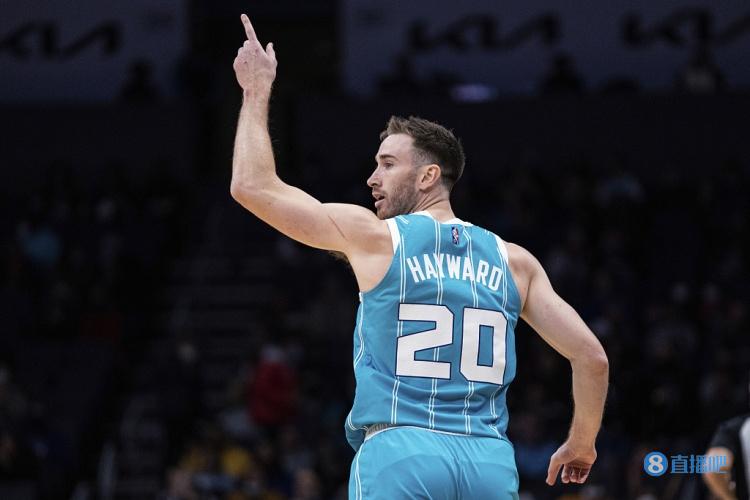
Recently, playing Game King is a bit high, and I have set up a permanent fire card group. The main strength of this card group is that it can also carry out an excellent offensive without a hand card, and then I play with it, I thought about the situation that players can also open up the situation for the team to score points on the attacking end without balls in NBA, and then as one of the representatives of the no-ball session-Hayward, the name popped out of my mind in an instant.
After the Celtics played “5-OUT” tactics in 2020-2021, the fans began to miss Gordon Hayward who had left the team one after another, after Horford and Owen left the team one after another, Hayward shone in the 19-20 season (that is, in his last Celtic season). He could make a starting point for tactics on the court, you can also make an end point without a ball. He can score about 17 points in the game efficiently, the rebound rate and efficiency have all reached their own new highs since All-Star season-this is also one of the important reasons why Grandpa Qiao took him to the wasp.
When he entered the league in 2010, Hayward was famous for his excellent running consciousness and basketball intelligence quotient. At that time, Larry Byrd (still working in Pacers) he wanted to bring him back to Indiana with all his strength. Later, Hayward gradually became one of the best strikers in the league one year after another. Next, let’s take a look at how Hayward shows his excellent skills of empty-handed combination.
Hayward has always been not a striker who occupies the right to play the ball. No goal has always been one of his ways to attack, which was no exception during the Jazz period.
As shown in the figure:

The picture above shows a tactic in the playoffs between the jazz and the Clippers in the 16-17 season. Hayward made a dislocation without a ball in the low position, and he turned around and cast it directly receive the ball-this attack line tactic is very common in Utah Jazz.
The original tactical arrangements are as follows:

Position 5 holds the ball high, position 1 falls near the restricted area, and position 3 cuts in from the bottom line of the weak side;
The 1-3 position is used as a cover for relieve a garrison, and the 3 position is misaligned. The 1 position slides out to arch top by cover, and the 5th position and the 1th position exchange ball rights;
The number 3 card position is moved up to prepare for receive the ball, and the number 5 position is taken as the number 2 position as a cover, and the number 4 position goes to the weak side bottom corner.
The whole set of tactics tests the executive power of Position 1 and the personal ability of position 3. In addition to the first dislocation point of position 3, there are also several random opportunities, we will not elaborate on it after ordering:
There is a vacancy when putting up position 1, which can be directly converted to shooting at freethrow line receive the ball;
The number 5 will attack receive the ball after the number 3 is Rim;
If the number 3 position cannot be receive the ball, the number 1 position can be selected when the number 2 shooter takes the cover of the number 5 position;
Then we know the overall tactical arrangement, and we can continue to look at the situation that we will encounter later:
Situation: opponent’s high-pressure man-to-man defense

George Hill hopes to lead Paul to Hayward and force his opponent to relieve a garrison. Joe Johnson in the bottom corner has not slipped away because his opponent’s bottom line is guarded and his tactics cannot continue. What should he do?
According to coaching board, if you encounter Tactical stagnation in step 2, observe the position of 1-5-3 three people. This tactic can be changed to “3-5 Horns”, and the number 1 hand in the ball and the number 5, the number 3 position is raised and the number 5 position is handed by hand. The number 5 position immediately goes down to find the air relay opportunity.
In the above figure, the Clippers did not miss Gobel, but Hayward used his body to squeeze out the defense and found that little Jordan did not dare to supplement the defense and ended it with throwing.
Situation: the opponent’s joint defense

In fact, the Celts use joint defense to deal with it, which is relatively easy to carry out tactics. Although the Celts are joint defense stations, defenders are always doing relieve a garrison, so Hayward gets stuck in the position, joe Johnson handed in the ball directly to the Hill mentioned above for transmission, Hayward turned over and scored.
After the 17-18 season, Hayward moved to Boston, and Stevens did more ball-free tactics for Hayward. Let’s give one or two examples:
The first is a replica of the above commonly used tactics, but this tactical space will be better.

This replica Hayward’s no-ball strategy has been tried repeatedly in the 19-20 season. Stevens lost the step of No. 2 and changed it to the block removal dislocation of No. 3-4 (Hayward played 4 here), the number 4 enters the restricted area, and the number 5 is directly issued.
Hayward can choose from this tactical arrangement:
A. Anti-running lick basket as shown in the picture
B. Get stuck in the position of the opponent’s defender, and eat strongly in the restricted area, which is shown in the following figure against the Eagle:
The other is “FIST 5 OUT 13”. This tactic is one of the more commonly used ballless tactics carried OUT by Celtics for Hayward in the 19-20 season. The original tactical picture is:

This tactic is relatively simple, but it also tests the ability to shoot receive the ball without a ball point. Position 1 is pulled to the other side, and position 5 is used as a cover for position 3, number 3 arch top receive the ball projection or go to position 5 again to find the middle distance or basket opportunity.
The Celts have created a better position for this tactic-mainly taking advantage of Ken BA’s good ability to get rid of the ball and have a good ability to attack independently.
The actual situation is as follows:

Without introducing the whole tactic, we can easily understand this tactic as the high-level double cover tactic of kenba, because you can see that kenba already has a good chance to make a move, this is also what Stevens wanted to see. Augustine and awandu who went online were all ready to grab the ball thrown by kenba. Hayward appeared at this time, the real tactical end point is to use the fixed cover of position 5 to get three opportunities.
Then, if Hayward has no chance to play, he can choose to hang the cover again and score two points steadily at freethrow line (one thing to say, Hayward’s freethrow line jump shot is really accurate, and it is accurate to the outrageous one):
The following figure shows an example:

Tactics have been introduced a lot, but whether it is “FIST 5 OUT 13” or the basic “Pin-Down” cover to create low dislocation, hayward can implement all kinds of different ballless tactics so completely that he cannot do without his own top-level football dealer. The opponent’s defense strategy has been slightly changed, hayward can find a response in a flash, and seamlessly switch between the ball end and the ball end. It is true that his current athletic ability is not as good as before due to injuries, but with his rich experience in the court, he can still enrich the team system on the court and become the lubricant of the team’s offensive end.
(Kebei, Edogawa)



